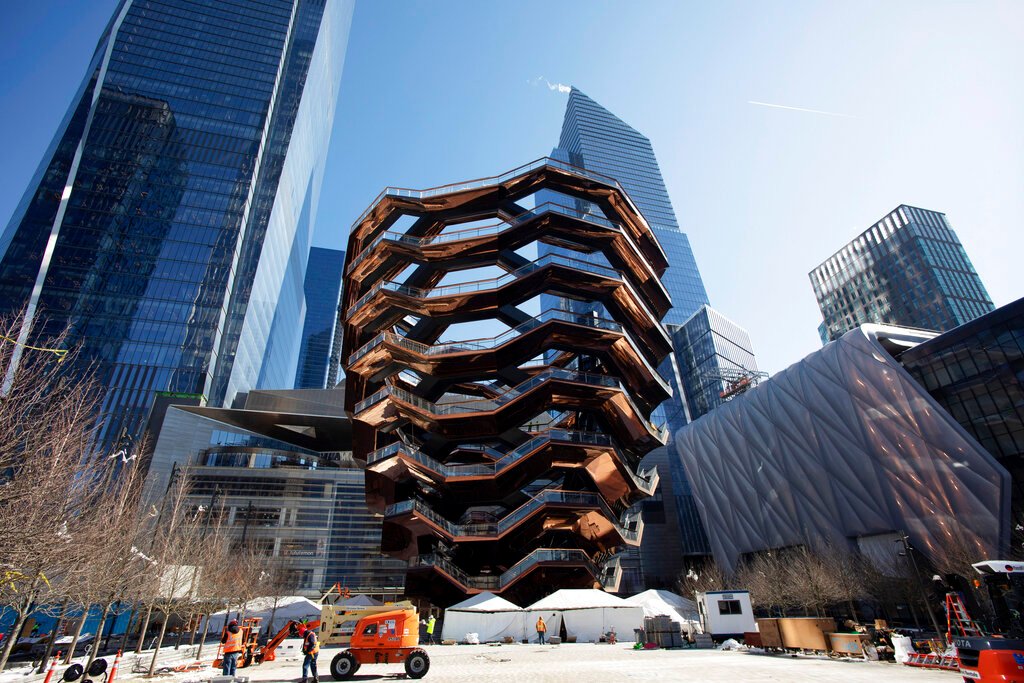 The “Vessel,” designed by Thomas Heatherwick, is a 150-foot-tall structure of climbable interlocking staircases, and the center point of the $25 billion Hudson Yards Redevelopment in New York. AP Photo/Mark Lennihan
The “Vessel,” designed by Thomas Heatherwick, is a 150-foot-tall structure of climbable interlocking staircases, and the center point of the $25 billion Hudson Yards Redevelopment in New York. AP Photo/Mark Lennihan
To receive Morning Links in your inbox every weekday, sign up for our Breakfast with ARTnews newsletter.
The Headlines
AFTER 55 YEARS, A CLOSED CASE IS BEING REOPENED. In 1966, the heiress and art collector Doris Duke killed the designer Eduardo Tirella, who curated her art collection, when she ran him over with her car at her home in Newport, Rhode Island. The police ruled it an accident. Now they are revisiting the matter, the Associated Press reports, after a man named Bob Walker said he heard the two arguing and saw Duke just after the event. (He was a 13-year-old paperboy.) Walker’s story contradicts the official narrative. In a new book, journalist Peter Lance makes the case that Duke murdered Tirella. In a Vanity Fair interview, Walker told Lance that, when he read his book, he decided, “I need to tell this story. The truth needs to come out.” He said that his father told him not to go to the police, fearing Duke might find a way to harm the teenager. The detective working on the case told Lance that she finds Walker’s account credible.
IT IS A DONE DEAL. On Thursday, the Constitutional Council in France signed off on most aspects of the nation’s Covid-19 health-pass program, which requires people to furnish proof of vaccination, a recent negative test, or recovery, to access museums, theaters, and other indoor spaces, the Associated Press reports. The measure went into effect on July 21 and is expanding to restaurants, cafes, and many other locations on August 9. Tourists from abroad are able to access the system at certain pharmacies, though some have reported complications. The French government said it is taking steps to ensure that those vaccinated outside the European Union can verify their status, according to Euronews.
The Digest
The digital-art organization Rhizome said it received its largest donation ever—fittingly, in the form of cryptocurrency—from artist Rafaël Rozendaal. The gift of more than 164 Ether, or about $430,000, came from half the proceeds generated by Rozendaal through the sale of 1,000 NFTs. [Press Release/ArtDaily]
Columnist Carolina A. Miranda slammed the San Francisco Museum of Modern Art’s plan to shutter its film program, its online magazine, and other offerings. “They may have not had massive audiences,” she writes, “but they incorporated a wide range of voices and made many of us feel as if there were at least one corner of the museum that cared about what Latino, Indigenous, Black and queer artists had to say about the world.” [Los Angeles Times]
Sotheby’s has sued Frederic Thut, the owner of Fine Art Auctions Miami, and his wife, Bettina Von Marnitz Thut, saying that they used forged provenance documents to sell fake Diego Giacometti works through the New York auction house. The couple has not yet commented. [Patch]
Archaeologists excavating the Ness of Brodgar in Orkney, Scotland, are seeking volunteers to move 500 automobile tires (or tyres, as the British have it) to hold down plastic that will protect the site through the fall and winter. (An unsolicited suggestion: When not in use, those tires could create a pretty great recreation of Allan Kaprow’s 1961 Yard.) [BBC News]
Research on artifacts unearthed at a Viking jewelry workshop dating to the 9th century suggests that women played a larger role in important festivals than previously thought, and that gender roles were more dynamic than some had believed. [National Geographic]
After studying a clay tablet from ancient Mesopotamia, an Australian mathematician believes that Babylonians may have discovered trigonometry some 1,500 years before the Greeks. [ARTnews]
The Kicker
WHAT WILL BECOME OF VESSEL? Now that Thomas Heatherwick’s New York work has closed indefinitely in the wake of a fourth suicide, a debate is raging in the architecture community about what should happen to it, Architectural Digest reports. Some are in favor of tearing it down or altering it. Writer Fred Bernstein, for one, has proposed removing the top half of the structure, while also wondering “if it could be sunk into the ocean for scuba divers or as an artificial coral reef for marine life.” A rep for Heatherwick’s studio said they are “distraught” about the deaths and “continue to work to identify a solution that is feasible in terms of engineering and installation.” [Architectural Digest]
Thank you for reading. We’ll see you on Monday.
Source link : https://www.artnews.com/art-news/news/doris-duke-curator-death-thomas-heatherwick-vessel-morning-links-1234601041












